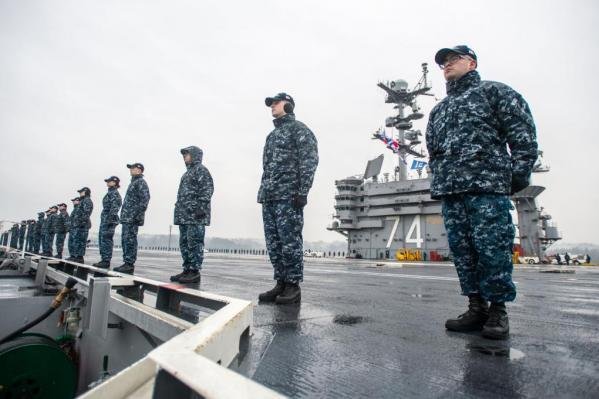Sailors stand on the deck of the USS John C. Stennis prior to a regularly scheduled deployment. Tensions ensued between the United States and China after the Stennis was refused to make a port call in Hong Kong. Photo courtesy of U.S. Navy
TOKYO, June 29 (UPI) -- Warships of the United States and China converged ahead of the biennial Rim of the Pacific exercise, a move that is, for now, setting aside tensions over Beijing's claims in the South China Sea.
Five warships from the Chinese navy participated in the training with U.S. vessels last week before the official start of RIMPAC exercises on Thursday, The Japan Times reported.
Ahead of the exercises, members of Congress and U.S. defense officials had asked China be excluded from RIMPAC, citing Beijing's unilateral claims to disputed islands in the South China Sea, USA Today reported.
Defense Secretary Ashton Carter, who has previously taken issue with a Chinese refusal to allow U.S. vessels, including the USS John C. Stennis, to make a routine port call in Hong Kong, said the invitation to China was extended because the exercises contribute to "relationships that are critical to ensuring the safety and security and peace of the region's sea lanes."
Washington may be downplaying the group sail, though, because of an incident involving Chinese spying on the U.S. military during the last RIMPAC exercises in 2014, analysts said.
The United States and China have been at odds for months over the issue of Beijing's island-building activities in the South China Sea.
Both sides are waiting on an international court ruling on Chinese activities in the Spratly Islands. The decision is likely to weigh in favor of the Philippines, the plaintiff in the case.
The exercises aren't designed, however, to send mixed messages to Beijing, but rather to fulfill a balancing act, a U.S. analyst said.
"The U.S. is trying to signal resolve and commitment to our allies and interests while maintaining as peaceful an atmosphere as possible, and walking this line means conveying two messages at the same time," said James Schoff of the Carnegie Endowment for International Peace.















